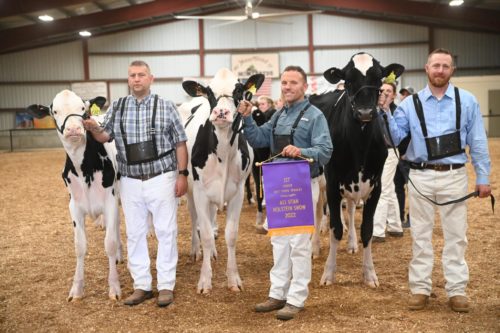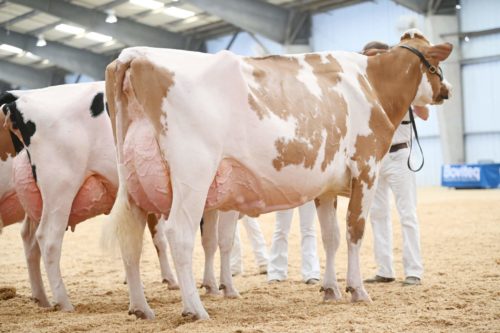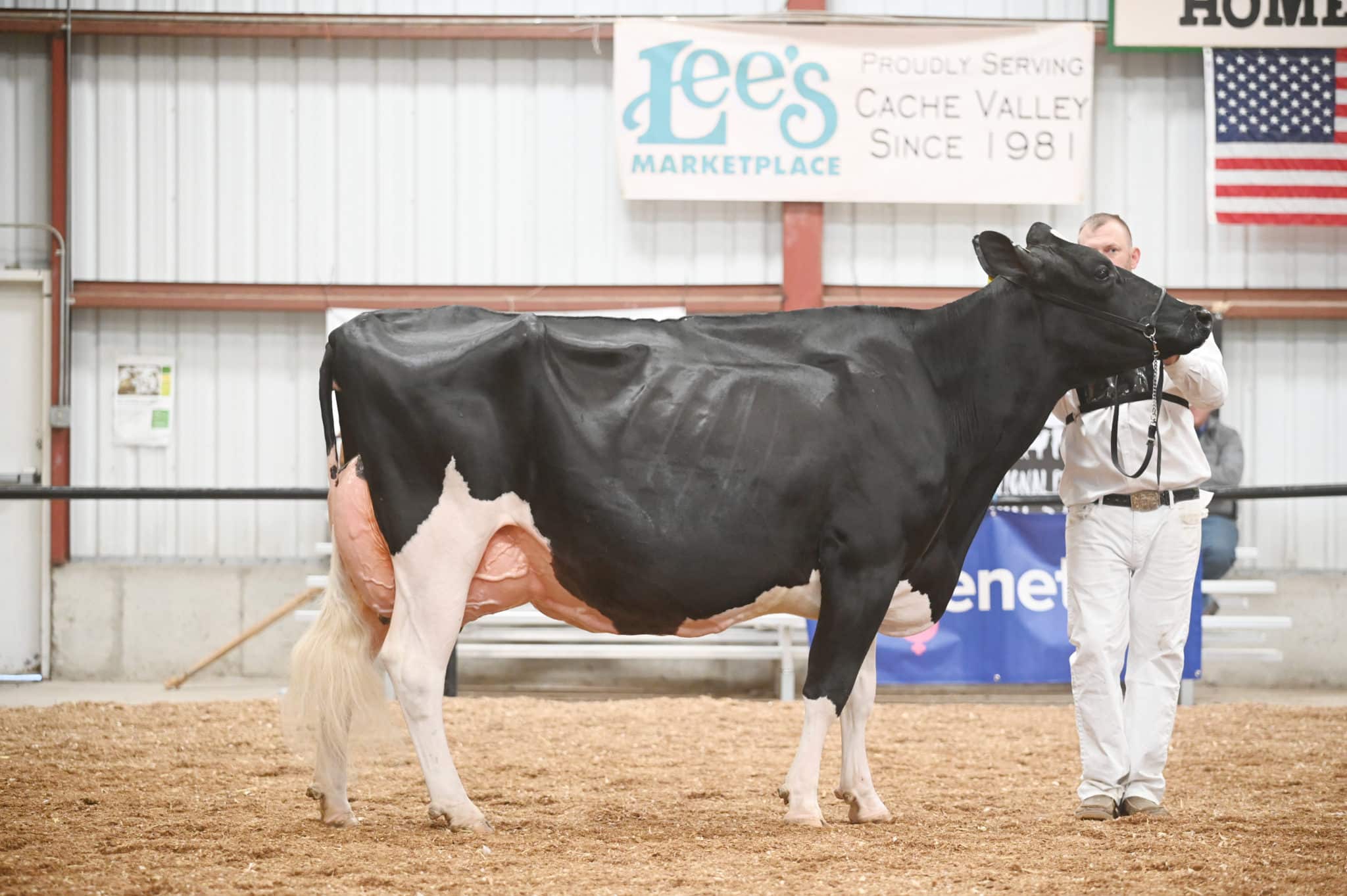A feature article from our Summer 2022 issue written by Kathleen O’Keefe.

Rivers of Milk in the Desert’ – it’s the tagline for EskDale Dairy and one of the truest brand mottos you’ll ever come across. Located in western Utah, only a few miles from the Nevada border, it’s pretty unlikely that you’ll find yourself just driving past EskDale on your travels. But, if you love deep-pedigreed, good-looking, purebred Holsteins, it’s worth the effort to plan a trip. Managed by Dr. John Conrad and his son, Ben, the well-managed herd has genetics sourced from across North America as well as a number of prolific homebred cow families.
The remote, but beautiful, location is home to the House of Aaron, a Christian non-denominational group, that established a communal settlement in Eskdale in 1955. While the EskDale prefix is now on cattle that have been exported around the world, the initial dairy herd on the property consisted of about ten crossbred dairy cows that John Conrad helped milk by hand. His father, Dr. Robert Conrad, was a leader in the church and re-located his family to the community. While his father never developed a great passion for cattle, John did and set his sights on getting his undergraduate degree from Utah State University, and then graduated from veterinary school at the University of California-Davis.
While at university, the herd changed its commercial scope to milking about 40 grade Holstein in a new parlor.

Over the years, John’s interest in dairy genetics kept pace with the expansion of the milking herd, which now numbers about 350 cows and a similar number of young stock. The cows are housed in large dirt/compost paddocks with open-sided shelters for shelter from the sun and adverse weather. “The open pens are wonderful for cows until you get bad weather. For about 11 months of the year in the desert, these cows can walk around and it’s comfortable. In late December and January, we can get down to 10 below zero and then it’s miserable for man and beast. We try not to have anything calving in that six weeks or so, just to get past the worst of the weather,” notes John. “We typically have a bit of a breeze, so that makes it nice. The desert climate always cools down at night, and that seems to be the key for getting the cows through the heat of the summer.”
With irrigation from the local water source and regular soil amendment, the community has turned a good bit of desert dirt into productive acreage for growing alfalfa and forage for the herd. “The water is good here. We have about a dozen pivots and, of course, need water for the cows and the dairy. We mainly rely on the snowmelt from the nearby mountains, but we also do need some rain each year,” comments John. “The aquifers are drawing down a bit and our water supply is always of interest to areas with more population.”

The dairy makes a significant contribution to the financial well-being of the community, so the herd needs to sustain a certain level of production. “We want the cows to make us money in the barn – the herd average is a little over 27,000M and 1,100F with a 4.0%F and 3.3%P. We breed and feed for components as we ship our milk 300 miles away – up to Gossner Foods in Logan, UT. It costs a lot of money to ship water, so we make sure we send a product that will pay us well. We haul our semi-tank tube to Delta (about ninety miles away), where there are a lot of bigger dairies, and they pick it up there and leave us a clean one.”
Both John and Ben admit that they really love the genetics part of the business, not just milking cows. They’ve been involved with a syndicate that buys a number of embryos every year from higher genomic level animals and try to hit that ‘home run’, so they do pay attention to the genomic segment. As breeders of their own cattle, they pay lots of attention to type. “Around here, we would not to go below +2.00 on type when breeding the genomic heifers and really, when it comes to breeding the herd, we like to be up around +3.00 on type,” admits John.
Though it can be a struggle with the time, manpower and distance, the Conrads do like to exhibit at the Western Spring National Show in Richmond, Utah (about a six-hour trip from the farm) and to the Utah State Fair every September. It’s often through the show at Richmond that EskDale cattle get marketed out to other areas of the country. In 2007, the herd saw two homebred cows garner All-American titles: EskDale Dundee Marcia Mona was named All-American Junior 2-Year-Old, while EskDale Stormatic Legend was selected as the All-American 4-Year-Old. Legend went on to be scored EX-95 2E, and Mona (who was sold to Arethusa Farm at World Dairy Expo) re-sold in the 2008 Global Glamour Sale for $152,000. Two All-Americans in one year is an amazing accomplishment for any establishment, and those two cows anchored the Reserve All-American Senior Best Three group for the farm that same year.

Legend, by Stormatic, was out of Ever-Green-View Legacy EX-90, a Convincer daughter of Ever-Green-View Le Grant, an EX cow with a record over 50,000 lbs. of milk – she reflects the Conrad’s willingness to look for genetics outside their herd. Mona EX-92, on the other hand, was a 5th generation homebred cow who eventually went on to be named the Holstein USA 2009 Star of the Breed for her owners, Siemers Holsteins.
“We’re not afraid to use a genomic or high-production bull on our show cows or a high-type bull on some of our higher index cows,” explains John. “We strive to breed good-looking cows that milk more as they mature. We do use aAa analysis. It helps ensure that we keep some balance in the herd. So many of the high-type bulls are 243 or some variation – we look for some bulls that are 156, 516 for balance. Both Mona and Legend – our All-Americans in 2007 – were bred that way.”
A more recent EskDale breeding success story is Ms Crushabull Carolina-ET VG-87, the Reserve All-American Senior 2-Year-Old in 2021 who was born at the farm in February 2019. Backed by a mile-long Roxy pedigree and by the new high-type sire, Crushabull, the heifer calf exemplified that balanced breeding they strive for. Golden Oaks bought her later that summer, and her genomic test was a home run with her landing over +4.00T and +3.23UDC. That fancy udder landed her in the second spot in the Senior 2-Year-Old class at Madison and on to her Reserve All-American title.
While they keep an eye on the genomic lists, they’re not married to always using the highest bulls. “A GTPI over 3000 doesn’t tell you much, but it does tell you that there are probably two or three generations of unproven genetics in the pedigree. We still value the accuracy of the numbers on proven sires. Too many dairymen look at GTPI and think it’s the same as TPI – if a bull has 20,000 daughters, that tells you something,” emphasizes John.
Because actual performance data is important to them in sire proofs, the Conrads try to do their part in providing that data through DHI test and classification. “We try to classify every round if it works with time of year and the weather. If it’s a cold time of year, we’ll do a special, since we just present them out here in the paddocks,” explains John. The herd ranks in the top 15 for BAA in the Westerns States region for 2021 with 306 head classified achieving a BAA of 108.1%.

Certain cow families work better in certain operations and that’s as true at EskDale as anywhere. “We’ve used a lot of genetics out of Dubeau Dundee Hezbollah because we love the dairy frames and they milk like crazy! They have horrible genomics for milk, but they milk their heads off. Plus they are very fertile – they breed and flush tremendously well and live to be six or seven years old. The dam of the winning summer yearling at Richmond this year, Borderview Summerfest Ruth-ET, was born here, changed hands a couple of times before Tim Abbott bought her back. We like to have offspring out of cow families that are well-known. Our cows get around because we’ll sell them!”
They sold a couple more from their Richmond show string this year: EskDale Moovin Cling-ET sold to T & L Cattle Ltd. and placed 2nd in the winter yearling class, while Siemers Main Molly 33580-ET, the winner of the Summer Junior 2-Year-Old class, sold after the show to Dymentholm Genetics and Duckett Holsteins. It’s hard to sell the good ones, but John recognizes the limitations of what they can do at the farm. “We just don’t have the help or expertise to develop cattle to compete at the very highest level, so it’s best for us to get them into the hands of people that can get them ready for the biggest shows if they have the potential.”
And, of course, it’s always nice to have a check in hand to reinvest in more cattle or in the facility. They’re at a point with the age of the original buildings to make some decisions about the future. “Ben will be the next generation to run this place and he doesn’t want to milk 600 cows. I think the herd size will stay pretty close to what it is now, though it’s hard to predict the future. We’re pretty conservative about spending a lot of money on new facilities. We made it through the last bad run of milk price without borrowing any money from the bank, but our parlor is showing its age. The milk price is good now and we are planning on building a new milking parlor,” John elaborates.
They always have their eye out for individuals from other cow families they admire that they can add to the herd as well. They enjoy having Red & White cattle in the herd and have bred, developed and owned some good ones. In the COVID year of 2020, the Western National Show was held in September instead of May, and they brought a beautiful-uddered Destry senior 3-year-old daughter to the show. It wasn’t long before they’d sold St-Jacob Destry Lava-Red to Grai-Rose Cattle and Arizona Dairy and Lava waltzed to the Grand Champion R&W title in Richmond on her way to an All-American R&W nomination. Now, solely owned by Arizona Dairy, Lava was Grand Champion of the California Spring Red & White Show as a 5-year-old earlier this spring.
A walk through the herd gives a visitor the chance to identify more up-and-coming stars, as every paddock reveals balanced cows with open rib, scope, and really good udders. The cattle have the calm, curious demeanor of animals that are treated well. John and Ben can identify them all during a tour and it’s a delight for anyone who enjoys talking pedigrees and sires. The conversation is dotted with references to cows like Lila Z, Chief Adeen, Hezbollah, Alicia, Wichita, Roxy, and many more.
Time will tell what the future holds for this small green oasis in the middle of the Snake Valley desert. Water is always a key factor, and population in the community is aging, but one thing seems clear and that’s the continuing interest and influence of the EskDale herd in the West!





